The Daze Of The
Knights
Donald stopped for a few
moments in the Upper Barrakka Garden and looked
outwards through one of the tall, modern,
limestone arches. Before him lay Malta’s
Grand Harbour, its turquoise-blue water whisked
into numerous white-topped peaks by the brisk
March wind.
Across the harbour stood
the ancient cities of Senglea and Vittoriose.
Donald gazed at the fortifications at the tip of
the peninsula on which Vittoriose stood - the 16th
Century walls of Fort St. Angelo. He reflected
that he must have studied the holiday brochure
with a greater intensity than he had recalled
because the view of those defences carried with
it a sense of deep familiarity - almost as if he
had been looking at a local landmark at home in
England.
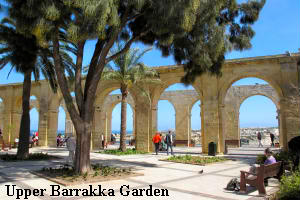 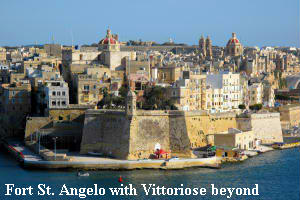
Donald zipped-up his jacket.
The breeze was not cold by English standards -
Maltese people who had never visited the United
Kingdom had no concept of “cold by English
standards” - it was, however, not quite
comfortable, and so he turned around and made his
way from the Garden and towards the centre of
Valletta.
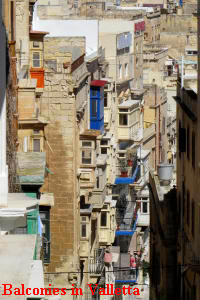 He had no
particular plan for the day so simply enjoyed
walking through the streets, taking-in the
atmosphere and looking at the orange-yellow
limestone buildings. Some had been constructed or
reconstructed after the Second World War. Others
had miraculously escaped the German and Italian
bombs but nevertheless displayed the scars of
battle in their stonework. At least some of these
buildings would have dated from the days of the
Knights. He had no
particular plan for the day so simply enjoyed
walking through the streets, taking-in the
atmosphere and looking at the orange-yellow
limestone buildings. Some had been constructed or
reconstructed after the Second World War. Others
had miraculously escaped the German and Italian
bombs but nevertheless displayed the scars of
battle in their stonework. At least some of these
buildings would have dated from the days of the
Knights.
Donald looked upwards.
Wooden balconies were perched on corbels
projecting from upper stories of the houses. Some
of the balconies were brightly painted in reds or
greens or blues. Others showed signs of neglect,
having long since lost any paint that had once
been applied to them. Washed clothes, in the
process of drying, fluttered frantically from
some, as if desperate to be carried away by the
blustering wind.
Donald stopped to take his
bearings and realised that he had reached the
dead centre of the city. He was standing outside
St. John’s Co-Cathedral. This was his first
visit to Malta, his first time in Valletta and
the first time he had seen the grand Cathedral of
the Knights of St. John. This sight, however,
once again engendered within him a strange sense
of familiarity. Without thinking, he ascended the
steps to the entrance of the Cathedral as if he
had habitually done so on numerous occasions.
It seemed to Donald that to
describe the interior of the Cathedral as
spectacular would have been an understatement.
Everywhere were intricate, elaborate carvings and
magnificent works of art. The nave and the side
chapels seemed to glow with a golden light,
reflected by the ornate Baroque decoration.
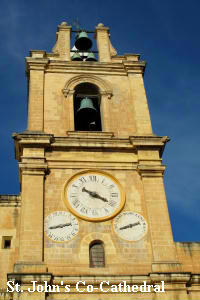 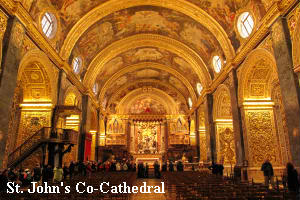
Donald paused at a side
chapel dedicated to one of the eight Langues -
the languages or nations into which the Knights
had been divided. ‘Don Miguel de Cordoba,’
he said, and stopped to wonder from where in his
memory that name had been awakened.
‘You are a scholar of
the Knights of St. John,’ said a voice from
behind him.
Donald turned to see an old
man in a black, flowing robe and the collar of a
priest. ‘I know virtually nothing about the
Knights,’ Donald replied to him.
‘How did you know
about Don Miguel de Cordoba?’ the man
enquired. ‘There are nearly four hundred
knights buried here, and Don Miguel was by no
means the most famous.’
‘I don’t know why
I said that name,’ said Donald, feeling
unsettled and perplexed. ‘...May I ask who
you are?’ he continued when he had recovered
his thoughts.
‘I’m Father
Augustus Acosta,’ said the man.
‘I’m the Cathedral historian.’
‘I’m Donald
Corren,’ said Donald. ‘I’m pleased
to meet you. Who was Don Miguel de
Cordoba?’
‘He was a Knight of St.
John,’ Father Acosta replied. ‘He came
to Malta in 1570 and lived here until he died in
1655. That period was part of a golden age for
the Knights. The Great Siege of 1565 was over and
had enhanced the reputation of the Knights,
leading to increased support from Europe. The
Knights were able to concentrate on developing
the island and enjoying their lifestyle.’
‘So, what did Don
Miguel do?’ asked Donald.
‘He was an
administrator,’ Father Acosta replied.
‘I’ve recently been looking into how
the Order managed the practicalities of everyday
life, so I’ve been studying those like Don
Miguel who oversaw the detail of routine affairs.’
‘I thought that
Knights travelled around, bravely righting wrongs
and undertaking chivalrous deeds,’ said
Donald.
‘There are a lot of
things that need to be done to maintain an Order
such as that of the Knights, not to speak of
running Malta,’ Father Acosta explained.
‘The Knights came from aristocratic families
across Europe. They were educated and so they
could write, discuss matters, plan and undertake
book-keeping.’
‘So, what was his life
like?’ asked Donald.
‘He would have
attended his office from nine in the morning
until five in the evening, with an hour for
luncheon. He would have had weekends off. That
was typical for "Knights of the Ordinary".’
‘Knights of the
Ordinary?’ said Donald, in a tone of enquiry.
‘Knights attracted to
their names epithets which characterised their
standing amongst their peers,’ Father Acosta
explained. ‘For example, one of Don
Miguel’s contemporaries, Gilbert de Mouton,
was known as Gilbert the Brave. Hugh de Chevalier
was known as Hugh the Wise. Many of the
island’s administrators were known by the
term “the Ordinary”. For example, the
person who managed the accounting for the
thirteen defensive towers funded by Martin de
Redin, Richard de Vere, was known as Richard the
Ordinary.’
‘What epithet was
afforded to Don Miguel?’ Donald enquired.
‘Initially he was
known as Don Miguel the Tedious,’ answered
Father Acosta. ‘Although after his wife ran
off with Philip the Well Endowed, he was often
referred to as Don Miguel the Sad Loser.’
‘I used to be an
administrator,’ confessed Donald, ‘and
my wife left me for someone called Philip, as she
said I was too tedious.’ Donald paused,
reflecting upon this coincidence. ‘Do you
believe in reincarnation?’
‘I am a Catholic,’
replied Father Acosta. ‘I believe that God
gives us each just one life. You are not the
first, however, to have this experience - to
become aware of a Knight and then to find
parallels between your life and his. Perhaps, on
a day like today, their voices, burned by the
Mediterranean sun into the very fabric of the
ancient structures on this island, are released
onto the wind and can be detected by those for
whom they have some sympathetic resonance. We
call this phenomenon the Daze of the Knights.’
‘Why was Don Miguel
known as “the Tedious”? asked Donald,
anxious to know more about this kindred spirit.
‘I believe he enjoyed
keeping meticulous records of all transactions
with which he was involved. He even took his work
home with him.’
‘There’s nothing
quite as satisfying as a neat column of
reconciled figures on a spreadsheet,’ Donald
empathised.
‘He liked to spend
hours at the entrance to the Great Harbour noting
the names of the boats that passed into and out
of the harbour,’ Father Acosta noted.
‘I think train
spotting is most interesting hobby there
ever could be.’ Donald volunteered a further
similarity from his own life.
‘He used to describe
the minutia of his everyday life in detail to
anyone who could not escape,’ continued
Father Acosta, pointing to a gravestone in the
floor of the Cathedral, just a few feet in front
of them. ‘That’s his tomb. Look at the
illustration that’s at centre, left.’
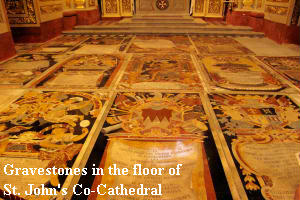 In common
with all the gravestones that comprised the
larger area of the Cathedral floor, Don
Miguel’s was inlaid with the richest marble
and porphyry in pietre dure. The image that
Father Acosta had indicated, depicted the Knight
holding forth on some issue, clearly of great
relevance to himself. Around him slumped his
audience, yawning or asleep. One knight even held
a sword to his own throat, clearly indicating
that a meeting with his maker would, to him in
that moment, be preferable to further attendance
upon Don Miguel’s discourse. In common
with all the gravestones that comprised the
larger area of the Cathedral floor, Don
Miguel’s was inlaid with the richest marble
and porphyry in pietre dure. The image that
Father Acosta had indicated, depicted the Knight
holding forth on some issue, clearly of great
relevance to himself. Around him slumped his
audience, yawning or asleep. One knight even held
a sword to his own throat, clearly indicating
that a meeting with his maker would, to him in
that moment, be preferable to further attendance
upon Don Miguel’s discourse.
Donald remained silent. The
parallels were beginning to feel a little
uncomfortable. ‘What happened to Don Miguel
in his later years?’ he asked.
‘I don’t know all
the details of individual knights,’ Father
Acosta replied. ‘Key aspects of his life may
be depicted on his gravestone.’ The Father
looked at his watch. ‘It has been
interesting meeting you,’ he said to Donald,
stifling a yawn, ‘but I must go about my
business.’
‘Yes, of course,’
said Donald. ‘Thank you for your time.’
‘Remember,’ said
Father Acosta before he turned to walk away,
‘that Don Miguel’s life is not yours.
You have the power to change the direction of
your own life.’
Donald thought about Father
Acosta’s words as he watched him walk down
the nave and disappear towards the Oratory.
Donald then turned and walked over to Don
Miguel’s gravestone. There were many small
illustrations upon it, presumably depicting
elements of the knight’s life. Donald noted
a garden which reminded him of his own membership
of the allotment society. Then there were a
number of small images showing various countries.
Perhaps those might parallel his stamp collecting
or even his annual, low cost, package holidays.
But what was this? At the
bottom of the gravestone were depicted bags of
money, then amphorae of wine, then young women in
various states of undress. It seemed to Donald
that Don Miguel had enjoyed a life altering
change of his fortunes in his later life, but
what had precipitated that? He looked at the
image just to the left of the money bags and then
withdrew his guidebook from his pocket. The image
was of a defensive tower with a small island
behind it, and a distinctive headland, beyond. A
very similar view appeared in his illustrated
guide. The caption read: “Wignacourt Tower,
St Paul’s Bay.”
~*~*~
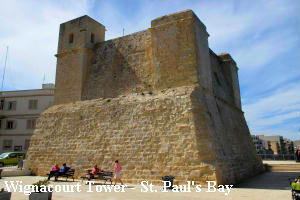 There was
not a cloud in the sky, but Donald was glad to
escape the continuing wind as he entered
Wignacourt Tower on the following morning. There was
not a cloud in the sky, but Donald was glad to
escape the continuing wind as he entered
Wignacourt Tower on the following morning.
A very helpful middle-aged
woman gave Donald his ticket and some explanatory
literature on the origins of this imposing,
limestone-block defence - now the oldest coastal
defence post on Malta.
‘Does the name of the
Knight, Don Miguel de Cordoba mean anything to
you? Donald asked her.
Before she could reply, a
sudden gust of wind scattered many of the
remaining leaflets across the floor. The woman
looked towards the narrow spiral staircase in one
corner of the tower. ‘I think the last
visitor didn’t properly close the door to
the roof,’ she said.
‘I’ll make sure I
close it,’ said Donald as he helped her
collect the papers. ‘The wind can badly
disturb things in the upper chamber too.’
‘You’ve been here
before, then,’ the woman surmised.
‘No,’ said Donald.
‘How do you know that
the stairs to the roof act like a chimney for the
breeze?’
Donald reflected that it
was a good question, but of a type that was
becoming familiar and less remarkable to him.
‘Does the name of the Knight, Don Miguel de
Cordoba mean anything to you? Donald reverted to
the subject of his initial enquiry.
‘A moment ago I would
have said no,’ she replied, furrowing her
brow in thought, ‘but the name does seem a
little familiar, somehow, although I can’t
recall more than that at the moment.’
~*~*~
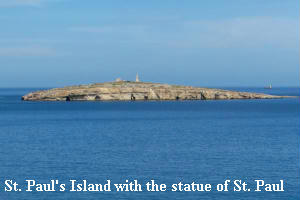 Donald
stepped onto the roof of the tower and closed the
door after him. He looked out across St.
Paul’s Bay towards St. Paul’s Island.
The white statue of St. Paul was clearly visible
on the island, half the height that the island
stood above the sea. Donald
stepped onto the roof of the tower and closed the
door after him. He looked out across St.
Paul’s Bay towards St. Paul’s Island.
The white statue of St. Paul was clearly visible
on the island, half the height that the island
stood above the sea.
Donald pulled his coat
about him to protect him from the wind. ‘The
second letter is in the well-shaft,’ he
heard himself involuntarily whisper.
It had always been one of
Donald’s skills as an administrator to focus
on analysing the particular matter of detail that
lay before him and not to become side-tracked by
excessive consideration of the broader context.
He therefore did not ponder on whatever mystical
link he might have with Don Miguel the Sad Loser,
and he did not think about how that connection
had taken him from the Upper Barrakka Garden to
St. John’s Co-Cathedral and then to
Wignacourt Tower. Instead he asked himself what
the second letter was, and where the well could
be found?
One possible answer to his
second question lay in the upper chamber, below
him. During the time of the Knights, water for
the soldiers who had been on duty in the upper
chamber had been drawn from a well below the
tower. In the wall of the upper chamber was a
door to a shaft within which hung a wooden bucket
that could be hoisted to and from the well below.
Donald opened the roof door
and began to descend the worn stone steps to the
upper chamber, pausing briefly to secure the door
behind him in the automatic, unthinking, habitual
fashion that he might have closed his own front
door.
Once in the upper chamber,
Donald stood at the well opening and placed his
hand inside. He touched the far wall and
stretched his arm and hand downwards across two
of the limestone blocks that formed the shaft, to
the point where he could feel a stone
protuberance. He knocked it sideways with his
palm, causing a small door in the block to open.
Finally he removed the sealed clay box from its
hiding place.
‘I found this in the
upper chamber,’ said Donald to the woman in
the lower room, handing the box to her. ‘I
think it might be important.’
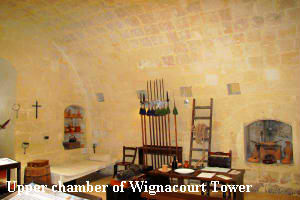 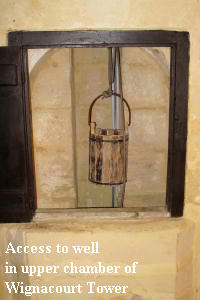
~*~*~
Epilogue:
The rest of this story is
now, of course, history.
It has since been widely
reported how Don Miguel de Cordoba discovered two
scrolls at St. Paul’s Bay, Malta. These
letters had been written by St. Paul during the
three months he spent on the island following his
shipwreck in 60 AD.
The letters had confirmed
the exact details of his shipwreck, but had also
contained quotations by Jesus that had been
contrary to Church teachings. Don Miguel had
become concerned that the Pope might, as a result,
destroy the artefacts, and so had revealed the
existence of just one.
The Church had taken the
first scroll, suppressed the heretical opinions
of Jesus that it had contained and sealed the
document in the vaults of the Vatican. Don Miguel
had been been paid a king’s ransom
ostensibly for his discovery, but also for his
silence. He had concealed the second letter in
Wignacourt Tower, together with a note by himself
explaining the above, for discovery in some more
enlightened times.
Donald was credited with
the discovery of Paul’s second letter and
the note containing Don Miguel’s explanation.
The modern Order of the Knights of St. John,
known as the Sovereign Military Hospitaller Order
of St. John of Jerusalem of Rhodes and of Malta,
based in Rome, were required by ancient covenant
to award him five million pounds for the find.
The rediscovered letters
were, in common with their predecessor, quickly
consigned to the vaults of the Vatican, so it
remains unclear as to exactly which elements of
the teachings of Jesus are considered to be un-Christian
by the Catholic Church. Fortunately the Church
has, thus far, chosen not to posthumously
excommunicate either Jesus or St. Paul.
Donald considered the
comments of Father Acosta that he need not live
his life to the precise pattern of that of Don
Miguel de Cordoba. However, the final
illustrations on the Knight’s tomb -
numerous wine amphorae and endless young women in
various states of undress - seemed to him to
constitute a satisfactory life plan. He had been,
he thought, a little conservative for too much of
his life. In the end, he deviated slightly from
the exact images by buying wine in cases due to
the modern shortage of amphorae.
Finally, since the whole
story was reported in Time Magazine, the
Upper Barrakka Garden is often crowded in March
and April on days when the cool Mediterranean
wind blows just a little too briskly for comfort.
Some visitors, perhaps, hoping that a voice from
long ago may speak on the breeze and transport them
into the Daze of the Knights.
|